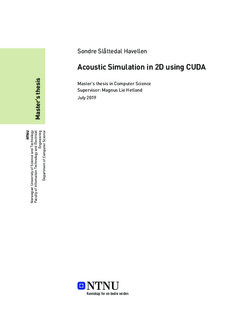Akustisk Simulering i 2D ved hjelp av CUDA
Master thesis
Permanent lenke
http://hdl.handle.net/11250/2625801Utgivelsesdato
2019Metadata
Vis full innførselSamlinger
Sammendrag
Denne oppgaven undersøker hvordan GPU kan brukes for å simulere akustikk i virtuelle rom. Denne oppgaven presenterer matematisk teori om akustikk, flere FDTD-metoder, samt implementering og evaluering av metodene. Videre er to applikasjoner implementert; en for å simulere akustiske bølger på GPU ved hjelp av CUDA og en VST for å anvende de resulterende impuls responsene fra simulatoren med et innkommende lydsignal. Eksperimentelle resultater viser at denne tilnærmingen til en fysisk basert VST-plugin kan ha potensiale, selv om artefakter som numerisk spredning (numerical dispersion) og lav ytelse fortsatt forhindrer praktisk bruk av applikasjonen. This thesis explores how the GPU can be employed in order to simulate acoustical reverberation in virtual spaces. This thesis presents mathematical theory of acoustics, several FDTD methods as well as implementation and evaluation of them. Two applications are implemented; one for simulating acoustical waves on the GPU using CUDA and one VST for convolving the resulting impulse responses from the simulator with an incoming audio signal. Experimental results show that this approach to a physically based VST plug-in might be viable, although artifacts such as numerical dispersion and low computational efficiency might prevent it from reaching its potential.
